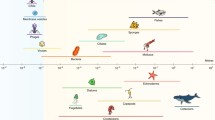Abstract
The timing of lytic phage development and the relationship between host generation times and latent periods were investigated by electron microscopy of one-step growth experiments in two strains of marine Vibrio species. Results were used in a correction factor developed to interpret field studies of phage-infected marine bacteria. Both the number of mature phage per average cell section and the percentage of cells with mature phage increased exponentially by 73–86% into the latent periods. Assuming that bacterial infection and lysis take place continually in the ocean, conversion factors for relating the percentage of visibly infected bacteria to the total percentage of the bacterial community that are phage-infected were calculated as 3.70–7.14. When this range of factors was applied to previously-collected field data [Proctor LM, Fuhrman JA (1990) Nature (Lond) 343:60–62; Proctor LM, Fuhrman JA (1991) Mar Ecol Prog Ser 69:133–142] from 3 to 31% of the free-living bacteria and 3 to 26% of particulate-associated bacteria appeared to be phage-infected at any given time. Based upon a steady-state model in which half the daughter cells survive to divide again, the percent of total mortality would be twice the total percentage of phage-infected cells. From 6 to 62% and from 6 to 52% of mortality for the free-living and particulate-associated bacterial community, respectively, may be due to viruses.
Similar content being viewed by others
References
Adams MF (1959) Bacteriophages. Inter-Science Publ, Inc, New York
Ahrens VR (1970) Untersuchungen zur Verbreitung von Phagen der Gattung Agrobacterium in der Ostsee. Kieler Mecresforsch 26:102–112
Benson R, Martin E (1981) Effects of photosynthetic inhibitors and light-dark regimes on the replication of cyanophage SM-2. Arch Microbiol 129:165–167
Bergh Ø, Børsheim KY, Bratbak G, Heldal M (1989) High abundance of viruses found in aquatic environments. Nature (Lond) 340:467–468
Børsheim KY, Bratbak G, Heldal M (1990) Enumeration and biomass estimation of planktonic bacteria and viruses by transmission electron microscopy. Appl Environ Microbiol 56:352–356
Bratbak G, Heldal M, Norland S, Thingstad TF (1990) Viruses as partners in spring bloom trophodynamics. Appl Environ Microbiol 56:1400–1405
Carlucci AF, Pramer D (1957) Factors influencing the plate method for determining abundance of bacteria in sea water. Proc Soc Exp Biol Med 96:392–394
Cotas-Robles EH, Espejo RT, Haywood PW (1968) Ultrastructure of bacterial cells infected with bacteriophage PM2, a lipid-containing bacterial virus. J Virol 2:56–68
Dahlberg JE, Franklin RM (1970) Structure and synthesis of a lipid-containing bacteriophage. IV. Electron microscopic studies of PM2-infected Pseudomonas BAL-31. Virol 42:1073–1086
Dulbecco R, Ginsberg HS (1980) Virology. Harper and Row, Philadelphia
Ellis EL, Delbrück M (1939) The growth of bacteriophage. J Gen Physiol 22:365–384
Frank H, Moebus K (1987) An electron microscopic study of bacteriophages from marine waters. Helgoländer Meeresunters 41:385–414
Franklin RM, Sladitt M, Silbert JA (1969) Structure and synthesis of a lipid-containing bacteriophage. I. Growth of bacteriophage PM2 and alterations in nucleic acid metabolism in the infected cell. Virology 38:627–640
Jannasch HW, Jones GE (1959) Bacterial populations in seawater as determined by different methods of enumeration. Limnol Oceanogr 4:128–139
Johnson RM (1968) Characteristics of a marine vibrio-bacteriophage system. J Ariz Acad Sci 5:28–33
Kellenberger E (1961) Vegetative bacteriophage and the maturation of the virus particles. Adv Virus Res 7:1–61
Kellenberger E, Sechaud R, Ryter A (1959) Morphological studies of phage replication. IV. The establishment of the DNA pool of vegetative phage and the maturation of phage particles. Virology 8:478–490
Moebus K (1983) Lytic and inhibition responses to bacteriophages among marine bacteria, with special reference to the origin of phage-host systems. Helgoländer Meeresunters 36:375–391
Proctor LM, Fuhrman JA (1990) Viral mortality of marine bacteria and cyanobacteria. Nature (Lond) 343:60–62
Proctor LM, Fuhrman JA (1991) The roles of viral infection in organic particle flux. Mar Ecol Prog Ser 69:133–142
Proctor LM, Fuhrman JA, Ledbetter MC (1988) Marine bacteriophages and bacterial mortality. Eos 69:1111–1112
Smith LS, Krueger AP (1954) Characteristics of a new Vibrio-bacteriophage system. J Gen Physiol 38:161–168
Valentine AF, Chapman GB (1966) Fine structure and host-virus relationship of a marine bacterium and its bacteriophage. J Bacteriol 92:1535–1554
Zachary A (1976) Physiology and ecology of bacteriophages of the marine bacterium Beneckea natriegens: salinity. Appl Environ Microbiol 31:415–422
Author information
Authors and Affiliations
Additional information
Offprint requests to: L. M. Proctor.
Rights and permissions
About this article
Cite this article
Proctor, L.M., Okubo, A. & Fuhrman, J.A. Calibrating estimates of phage-induced mortality in marine bacteria: Ultrastructural studies of marine bacteriophage development from one-step growth experiments. Microb Ecol 25, 161–182 (1993). https://doi.org/10.1007/BF00177193
Received:
Revised:
Issue Date:
DOI: https://doi.org/10.1007/BF00177193




